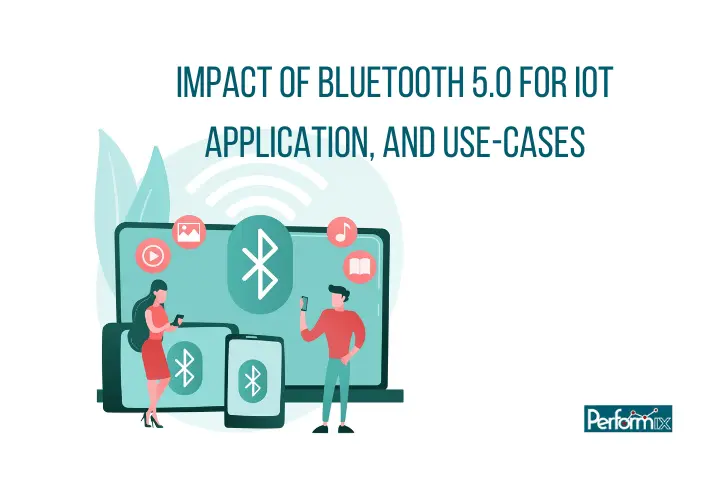For many years, Bluetooth has been an indispensable technology for wireless networking, allowing for near-seamless information exchange across various electronic gadgets. With the release of Bluetooth 5.0, the capabilities of this pervasive technology have been vastly improved, allowing for whole new IoT use cases to be explored. In this article, we’ll look at how Bluetooth 5.0 has changed the Internet of Things and the novel applications that have arisen.
Bluetooth 5.0: The Evolution of Connectivity
Bluetooth 5.0 is the most recent iteration of the Bluetooth specification, introducing several significant enhancements over its predecessor.
Bluetooth 5 provides four times the range, speed, and 800 percent more data transmission frequency than previous incarnations. Incorporating Bluetooth 5-enabled IoT devices enables businesses with extensive and vital infrastructure to achieve 100 percent uptime and cost-effective solutions by implementing Bluetooth 5-enabled IoT devices.
Bluetooth Low Energy (BLE), a Bluetooth variant optimized for low-powered devices, can help IoT devices conserve energy by keeping them in sleep mode until they are connected. BLE is ideal for IoT applications because it can associate and reconnect with devices in six milliseconds, whereas traditional Bluetooth requires six seconds. This not only increases device availability but also increases operational efficacy.
Bluetooth is the communication layer in a typical IoT architecture, including the hardware, communication, software system, and application layers. The communication layer, comprised of a multi-layer structure comprising data connection, network or transport, and session protocols, is a crucial link between the layers. Bluetooth, or BLE, is a data transmission layer connecting sensors and gateways. In contrast, the network layer relays or transports communications using the optimal network paths. Protocols at the session layer permit communication between diverse IoT communication subsystem components.
Bluetooth technology is less costly to implement than RFID, NFC, WLAN, LoRaWAN, LTE-A, and WiFi-Direct. It also enables wireless communication and the immediate creation of a Personal Area Network (PAN) in areas without wireless infrastructure. It employs a consistent methodology with minimal interference. In addition, Bluetooth’s standard range of 0–30 meters may be extended by enhancing the voltage beyond one milliwatt.

Why Bluetooth 5.0 will impact the IoT market positively
Here are the reasons.
Energy Conservation
Bluetooth 5.0 is becoming the preferred wireless technology for various IoT applications due to its efficient and low-power connectivity. This cutting-edge strategy guarantees that users will continue to enjoy increased efficacy with minimal power consumption, making it the optimal option for all connected devices in the future.
Improved Transmission Capabilities
Bluetooth 5.0 provides enhanced two-way transmission capabilities and wider bandwidth than earlier versions, allowing it to be widely adopted in applications such as Industrial IoT, consumer wearables, connected devices, and remote health monitoring implants that connect with nearby smartphones and transmitters.
Elongates Battery Life
Bluetooth 5.0 has revolutionized the way IoT devices communicate, allowing them to transmit vital data for longer periods and on longer battery life. Smart businesses utilize Bluetooth 5.0-enabled IoT devices to maximize their critical infrastructure and mitigate disruptions without expending excessive resources. Bluetooth Low Energy (BLE) technology conserves energy by keeping these devices dormant until activated.
Enables Fast Pairing
This innovative BLE-based technology enables rapid coupling and reconnection of devices in an astounding six milliseconds, revolutionizing the Bluetooth industry, where connections have historically taken up to six seconds. This enhanced operational efficacy can significantly improve the availability of a device.
BLE devices can discover and connect to any wireless network, including Wi-Fi and WiGig. This enables users to deactivate high-powered connections such as LTE until they require bandwidth. Transport Discovery Service (TDS) provides all devices with a common discovery and connection framework. This technology is essential because it enables devices to continue functioning while consuming minimal energy.
Location Consciousness
Bluetooth 5.0 is revolutionizing the marketing and advertising industry by providing a new medium to engage consumers in stadiums, museums, and other public venues. With its location awareness capabilities facilitated by BLE beacons, initiatives such as home automation and enterprise development are presented with intriguing new opportunities.
Click here to read Top Technology Trends for 2023 for Businesses to be Prepared for
Contextual Awareness
Context awareness technologies such as navigation and location tracking have become indispensable in the modern era. Such capabilities have numerous applications, including facilitating a seamless airport journey, assisting with asset management in warehouses, and facilitating the mobility of those with visual impairments. Moreover, these solutions provide us with vital additional protection during pandemics; real-time data analysis made possible by this innovative technology allows for better observation of social isolation practices.
Bluetooth 5.0 significantly impacts low-power technology, delivers effective solutions and establishes itself as the preferred consumer connectivity standard. This transition has rendered Wi-Fi routers and access points obsolete for many contemporary applications, including smart residences, healthcare facilities, warehouses, and factories.
Mesh Networking
Bluetooth 5.0 introduces mesh networking, enabling the construction of large-scale Internet of Things networks. This feature allows devices to relay data to one another, extending the network’s range and coverage. Bluetooth mesh networking is extremely scalable and self-healing, making it suitable for smart lighting, asset monitoring, and building automation applications. We will examine several use cases that use this capability and highlight its benefits.

Use-Cases
With the release of Bluetooth 5.0, Bluetooth technology has excelled to the point where it can play a crucial role in the revolution of IoT applications.
1. Personalized Healthcare Monitoring
Bluetooth 5.0 has revolutionized the healthcare industry by enabling customized monitoring solutions. Bluetooth-enabled IoT devices can perpetually monitor vital signs such as heart rate, blood pressure (BP), and glucose levels due to their minimal energy consumption and extended range. This data can be wirelessly transmitted to healthcare providers or caregivers, enabling real-time monitoring, early anomaly detection, and timely interventions.
The increased bandwidth of Bluetooth 5.0 enables the transmission of complex medical data, such as images and video, for telemedicine applications, facilitating remote consultations and reducing the need for in-person hospital visits.
2. Asset Tracking and Logistics
Bluetooth 5.0 has revolutionized asset monitoring and logistics by providing accurate and efficient location-based services. Attaching Bluetooth beacons or identifiers to assets enables real-time surveillance and tracking of their movement within a facility or throughout supply chains.
Do you know
According to analysts, the continued growth of Bluetooth Location Services devices can be attributed primarily to the increasing demand for asset-tracking anchor points and tags, causing a significant increase of 2.46 growth in annual shipments of Bluetooth Location Services devices from 2023 to 2027.
Source: www.bluetooth.com
With the advent of Bluetooth mesh networking, the coverage area can be greatly expanded, allowing for seamless tracking in expansive environments. This capability increases productivity, diminishes loss and robbery, and optimizes inventory management. In addition, the minimal energy consumption of Bluetooth 5.0 extends the battery life of asset-tracking devices, making them highly dependable and cost-effective.
3. Smart Agriculture
Bluetooth 5.0 has found useful applications in the agricultural sector, facilitating the implementation of intelligent farming practices. Bluetooth-enabled wireless sensors can collect information on soil moisture, temperature, humidity, and other environmental parameters. This information is then sent to a centralized control system for analysis and automated decision-making.
With Bluetooth 5.0’s increased range, farmers can monitor larger tracts of land, optimize irrigation systems, and implement techniques for precision agriculture. Bluetooth-enabled devices can also facilitate livestock surveillance, allowing producers to monitor animal health and location remotely. These developments in smart agriculture increase productivity, reduce resource waste, and promote sustainable agricultural practices.
Do you know
By deploying IoT sensors with Bluetooth connectivity, BeeHero collects real-time information on hive conditions, including temperature, humidity, and weight; this data is then transmitted wirelessly to a central system, where it is analyzed to gain insights into the health and well-being of the bee colonies.
Using Bluetooth technology in this context enables BeeHero to create a comprehensive monitoring network that covers a wide range of hives. With Bluetooth’s low energy consumption, the sensors can operate for extended periods without frequent battery replacements, ensuring continuous data collection without disrupting the hive’s natural environment.
Click here to read in detail–>Using IoT Sensor Technology to Produce Stronger, Healthier Colonies and Improve Pollination Outcomes
4. Industrial IoT Applications
Bluetooth 5.0 has made substantial inroads in the industrial sector, transforming conventional manufacturing processes into highly connected and automated systems. Bluetooth-enabled sensors and devices can capture machine data, monitor equipment health, and enable predictive maintenance due to their increased range and minimal energy consumption. This allows proactive defect detection, which minimizes disruption and maximizes operational efficiency.
Bluetooth mesh networking enables robust communication across expansive factory floors or complex industrial environments, allowing for the seamless integration and administration of many IoT devices. Bluetooth 5.0 also plays a crucial role in asset management by facilitating real-time tracking of equipment, inventory, and personnel, streamlining operations, and enhancing safety.
In the future, Bluetooth 5.0 will drive even more progress in IoT applications. More devices will be able to communicate with one another and stay connected more easily as a result of Bluetooth 5.0’s widespread adoption. Every day, Bluetooth 5.0 makes it much easier to create a future where a connection is ubiquitous, intelligent, and empowering.
In conclusion, Bluetooth 5.0 is an improvement in technology and a driver of transformational change. It opens up possibilities for creativity that have never been seen before. With more versions of Bluetooth technology, we could change how we live, work, and connect with the world.






